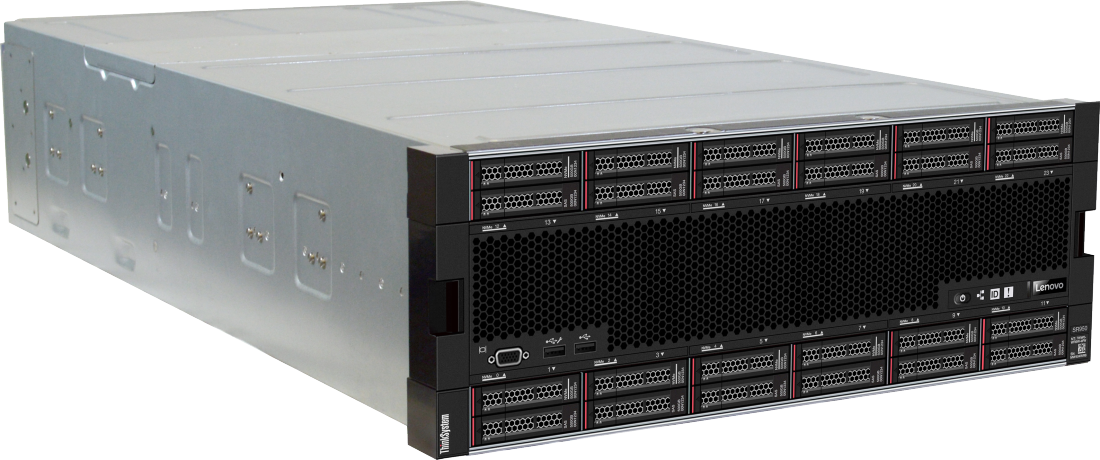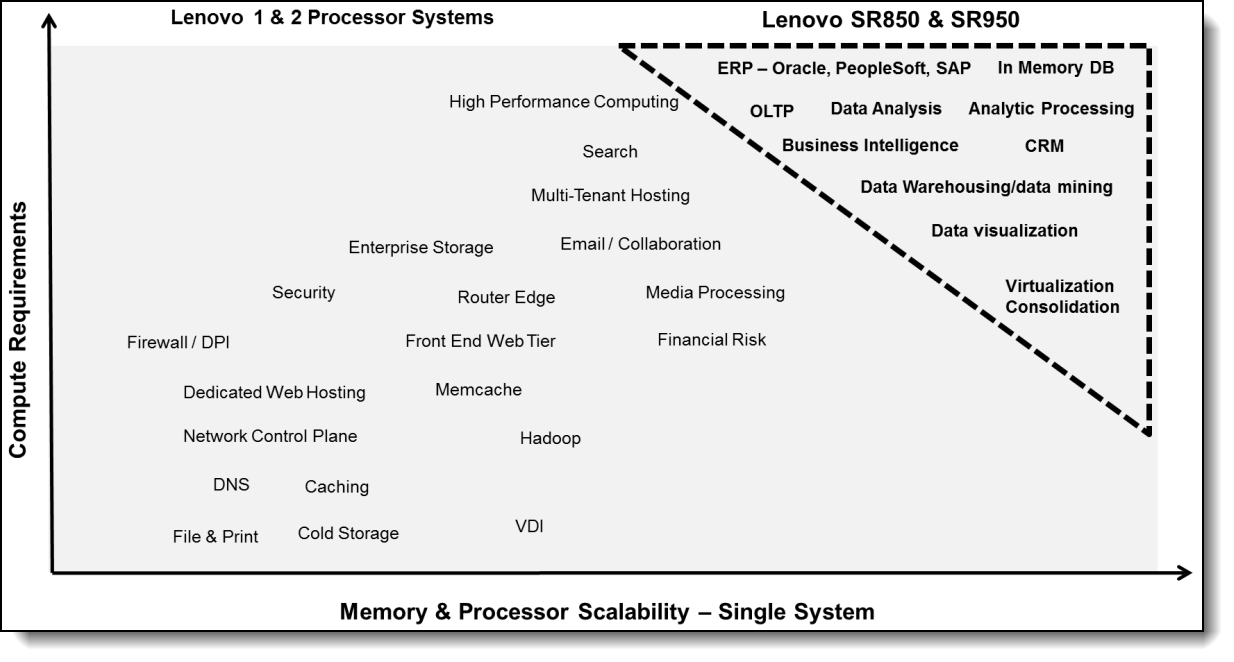Author
Updated
22 Nov 2019Form Number
LP0748PDF size
8 pages, 1.1 MBAbstract
Business Processing and Decision Support make up the largest and growing workloads for 4 & 8-socket servers. These workloads typically demand strong processing capability and a large amount of application memory. Many of these workloads are best suited for systems providing high memory and compute capabilities. Providing a scale-up deployment with high memory and strong processing is where the Lenovo SR850 and SR950 really shine.
Change History
Changes in the November 22 update:
- Updated to reflect the latest IDC Server Tracker
Video
Introduction
Deciding which server infrastructure is best suited for various workloads requires you to look at workloads categories, characteristics and requirements. Then look at which servers are best suited to support these workload characteristics and requirements.
4S and 8S Workload Market
Looking at 4S & 8S revenue by workloads in the following figure (IDC Semiannual Server Tracker: Workloads 2019H1) you can see that Business Applications and Data Management are the largest 4S & 8S Workload revenue producers.
These two workloads control a large share of the 4-8S market. These workloads are also supported by 2S servers but workloads such as IT Infrastructure and Web Infrastructure are highly focused on 2S servers.

Figure 1. 4S+ revenue by workload (IDC Semiannual Server Tracker: Workloads, 2019H1)
Key workloads categories
The workloads that the ThinkSystem SR850 and SR950 are most suited fall under the Business Applications and Data Management Applications categories: IDC defines Business Applications and Data Management as follows:
Business Applications
Business applications form the backbone for most business operations. They include enterprise resource management (ERM) applications, supply chain management (SCM) application software, operations and manufacturing applications, and customer relationship management (CRM) applications:
- Enterprise Resource Management (ERM) Applications - Enterprise resource management applications are designed to automate and optimize business processes related to resources required to meet business or organizational objectives but are not customer or prospect facing or specialized to various types of engineering. The resources automated include people, finances, capital, materials, suppliers, projects, contracts, orders, and facilities:
- Customer Relationship Management (CRM) Applications - Customer relationship management applications automate the customer-facing business processes within an organization, irrespective of industry specificity (i.e., sales, marketing, customer service, and contact center). Collectively, these applications serve to manage the entire life cycle of a customer — including the process of brand building, conversion of a prospect to a customer, and the servicing of a customer — and help an organization build and maintain successful relationships:
- Supply Chain Management (SCM) Applications - Supply chain management application software automates supply- and demand-side business processes that bring a product or a service to market, including multisite organizations involved in a complex supply chain process, including raw materials suppliers, contract manufacturers, 3PL and 4PL providers, and individual transportation and warehousing organizations:
Data Management
Data Management includes Structured Data Management Software, Structured Data Analytics and Unstructured Data Analytics.
- Structured Data Management Software - Structured data management software includes products that manage a common set of defined data that is kept in one or more databases (structures of managed data shared by multiple application programs) and is driven by data definitions and rules, whether this involves a single database accessed directly by applications or distributed databases accessed by multiple applications in multiple locations. A database management system (DBMS) is a software entity that manages a database in such a way that it may be queried and randomly updated.
- Structured Data Analytics - Data access, analysis, and delivery products are end user–oriented tools for ad hoc data access, analysis, and reporting as well as production reporting. Products in this category are most commonly used by information consumers or power users rather than by professional programmers.
- Unstructured Data (Content) Analytics – Includes Cognitive/Enterprise AI software that provides the functionality to analyze, organize, access, and provides advisory services based on a range of structured and unstructured information. It also includes Content Analytics and Search Software that analyzes, extracts, and organizes structured data from unstructured information and uses that structured data to find, locate, and provide answers and pertinent information to knowledge workers
Business Processing & Decision Support Requirements
The two primary 4- and 8-socket workloads are Business Applications and Data Management. These workloads are the most demanding in the Enterprise requiring high compute capabilities and memory/processor scalability to meet the increasing workload demands.
Compute Requirements – Faster transaction speeds and accelerated operations mean real-time responsiveness, quick results, and increased productivity. Fast compute allows you to handle today’s unprecedented growth in data volumes and improve the accuracy and precision of workloads requiring high performance.
Memory & Processor Scalability – Scalability allows a system to expand to meet increasing performance and sizing workload demands. Scaling memory is how much memory you can add to your server. Processor scaling is the ability to increase your number and capability of the CPUs in your system. Enterprises need assurance that the architecture is designed in such a way that system capacity can be increased as the needs of the business change.
Breaking Business Applications and Data Management categories down into applications and more defined categories, we can see how these compare to applications with less compute and memory requirements. The applications/workloads with either lower compute or lower memory requirements tend to be support by Lenovo 1 and 2 processor servers. The ones with both high compute and memory requirements are where the SR850 and SR950 are the best choice to run these workloads.
Why ThinkSystem SR850 and SR950?

Figure 3. Lenovo ThinkSystem SR850
The ThinkSystem SR850 and SR950 both provide high compute requirements, memory/processor scalability as well as other capabilities necessary to support these demanding business process and decision support workloads:
- Memory. The SR850 and SR950 have at least 2X the memory capabilities of two socket servers. The SR950 provides up to 96 DIMM slots and up 24TB of memory required for large virtual machines and in-memory databases.
- Performance. The SR850 and SR950 provide at least 2X the compute performance of two socket servers. The SR950 has several World Record benchmark performances.
- Agility. The SR850 scales from 2S – 24 DIMM to 4S-48DIMM. The SR950 provides 2S-24DIMM to 8S-96DIMM. These systems allow clients to add, modify or easily upgrade components for storage, compute and I/O.
- Increased I/O. The SR950 provides up to 17 rear networking slots and the SR850 provides up to 10 rear networking slots. This compares to typical two socket systems providing 7-8 I/O slots.
- Advanced RAS. Both systems fully support advanced Reliability, Availability and Serviceability (RAS) capabilities no matter what CPU is configured. Mission critical applications require the highest level of RAS available.
- Handling workloads that require high compute and scalability for both memory and processor, is where the SR850 and SR950 shine.

Figure 4. Lenovo ThinkSystem SR950
Further Reading
For further reading, see these resources
This article is one in a series on the ThinkSystem SR950 and SR850 servers:
- Five Highlights of the ThinkSystem SR950
- Five Highlights of the ThinkSystem SR850
- Choosing between Lenovo ThinkSystem SR850 and SR950
- Workloads for 4-Socket and 8-Socket Servers
- Usability in the Design of the ThinkSystem SR950
- The Value of Refreshing Your 4-Socket Servers with the ThinkSystem SR950
- ThinkSystem SR950 Memory Decisions
- ThinkSystem SR950 Server Configurations
- The Value of Refreshing Your 8-Socket Servers with the ThinkSystem SR950
- Lenovo ThinkSystem SR950 New Options and Features - December 2017
- ThinkSystem SR950 Performance Leadership
- Lenovo Servers for Mission Critical Workloads
- Microsoft and Lenovo ThinkSystem SR950 – A Perfect Match
- Accelerate Your 4- and 8-Socket Server Refresh Cycle
- SAP Business Process Applications and Lenovo ThinkSystem SR950 – A Perfect Match
- ThinkSystem SR950 New Options - March 2018
- SAP HANA and Lenovo ThinkSystem SR950 – A Perfect Match
- ThinkSystem SR950 Performance Leadership Continues
- New Solution for SAP HANA - Lenovo ThinkAgile HX
- The Advantages of Keeping Mission Critical Workloads On-Premises vs Going to the Cloud
About the author
Randall Lundin is a Senior Product Manager in the Lenovo Infrastructure Solution Group. He is responsible for planning and managing ThinkSystem servers. Randall has also authored and contributed to numerous Lenovo Press publications on ThinkSystem products.
Trademarks
Lenovo and the Lenovo logo are trademarks or registered trademarks of Lenovo in the United States, other countries, or both. A current list of Lenovo trademarks is available on the Web at https://www.lenovo.com/us/en/legal/copytrade/.
The following terms are trademarks of Lenovo in the United States, other countries, or both:
Lenovo®
ThinkAgile®
ThinkSystem®
The following terms are trademarks of other companies:
Microsoft® is a trademark of Microsoft Corporation in the United States, other countries, or both.
Other company, product, or service names may be trademarks or service marks of others.
Configure and Buy
Full Change History
Course Detail
Employees Only Content
The content in this document with a is only visible to employees who are logged in. Logon using your Lenovo ITcode and password via Lenovo single-signon (SSO).
The author of the document has determined that this content is classified as Lenovo Internal and should not be normally be made available to people who are not employees or contractors. This includes partners, customers, and competitors. The reasons may vary and you should reach out to the authors of the document for clarification, if needed. Be cautious about sharing this content with others as it may contain sensitive information.
Any visitor to the Lenovo Press web site who is not logged on will not be able to see this employee-only content. This content is excluded from search engine indexes and will not appear in any search results.
For all users, including logged-in employees, this employee-only content does not appear in the PDF version of this document.
This functionality is cookie based. The web site will normally remember your login state between browser sessions, however, if you clear cookies at the end of a session or work in an Incognito/Private browser window, then you will need to log in each time.
If you have any questions about this feature of the Lenovo Press web, please email David Watts at dwatts@lenovo.com.

